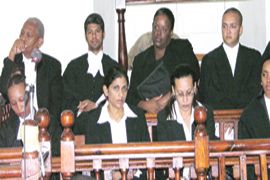Brief history of the Eastern Caribbean Supreme Court

In 1967, the Organization of Eastern Caribbean States – namely Antigua, Anguilla, Dominica, Grenada, Saint Vincent, Saint Kitts & Nevis, and Saint Lucia – joined in a new “status of association” with the United Kingdom, in accordance with the West Indies Act of 1967. The Act provided for Her Majesty by Order in Council to establish common courts for the Associated States with “such jurisdiction and powers as may be so specified or determined.” The Order in Council also allowed provisions to be made for the establishment in common of a commission to appoint judges and officers of the Court; for the remuneration, allowances, and pension rights of the commission, as well as the judges and officers of the Court; and for defraying the expenses of the Commission and the Courts.{{more}}
The West Indies Associated States Supreme Court Order duly followed and gave effect to Section 6 of the West Indies Act, permitting the establishment of common courts for the Associated States – “West Indies Associated States Supreme Court”. Since then, this Order has been given constitutional recognition and effect by two successive Constitutions, the Associated State Constitution of 1967 and the Independence Constitutions of the respective States beginning with the Independence Constitution of Grenada in 1974.
The most important change initiated by the Supreme Court Order was the fusion of the High Court and Court of Appeal into one Supreme Court, and the confinement of all appeals to the Court of Appeal. The previous duality, which allowed the appellate jurisdiction to be shared by different appeal courts, was abolished.
This new arrangement helped to facilitate greater supervisory jurisdiction over the legal system of the individual states by the Supreme Court. It was, however, left to the Constitutions of the individual states and the local legislatures to enact statutory provisions to give flesh to the Supreme Court Order of 1967.
The civil jurisdiction of the former Supreme Court of the Windward and Leeward Islands was vested in the High Court of the now-established West Indies Associated States Supreme Court.
Court of Appeal
Following the West Indies Act, 1967, the Hon. Chief Justice Sir Allen Lewis, Justice Keith Gordon and Justice P. Cecil Lewis comprised the Bench of the first sitting of the Court of Appeal.
Sir Allen Montgomery Lewis served as Chief Justice from 1967 to 1972 when he retired from the post of Chief Justice and brought his judicial career to a close. He was replaced by Acting Chief Justice P. Cecil Lewis (1972 – 1975).
Subsequent Chief Justices in chronological order, up to present time, are: Sir Maurice Davis (1975 – 1980); Sir Neville Peterkin (1981 – 1983); Justice Neville Berridge [Ag.] (1983 – 1984); Sir Lascelles Robotham
(1984 – 1991); Sir Vincent Floissac, QC, OBE, CMG (1991 – 1996); Sir Dennis Byron (1996 – 2004), who is currently on leave of absence on a three year contract as permanent judge with the Rwanda Tribunal; Justice Adrian Saunders [Ag.] (2004 – 2005); Justice Brian Alleyne, SC [Ag.].
The West Indies Associated States Supreme Court, now styled as the Eastern Caribbean Supreme Court, was initially housed in the West Indies Associated States Secretariat in Grenada, until it moved to Saint Lucia in 1982.









